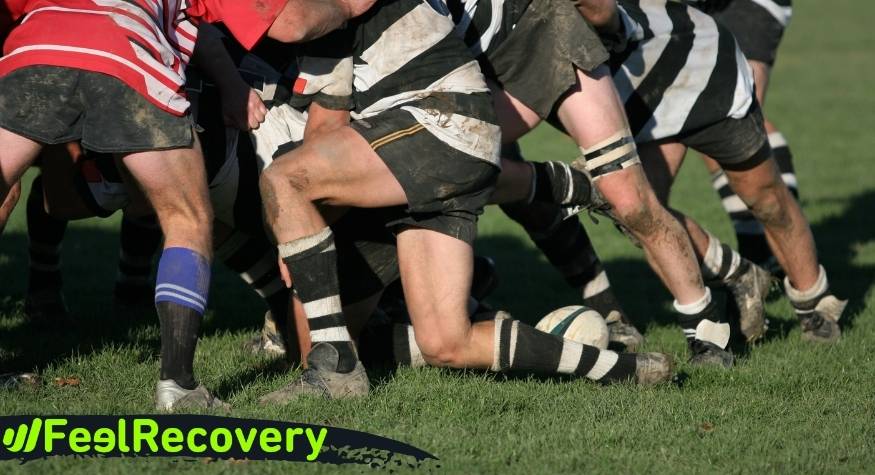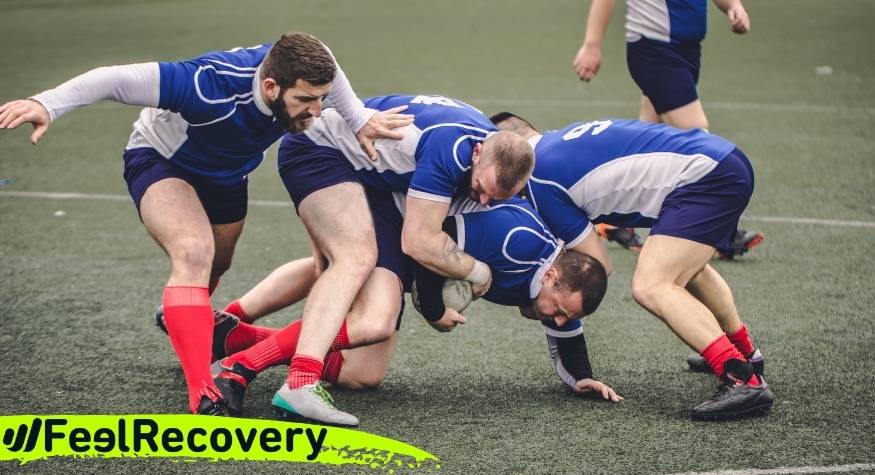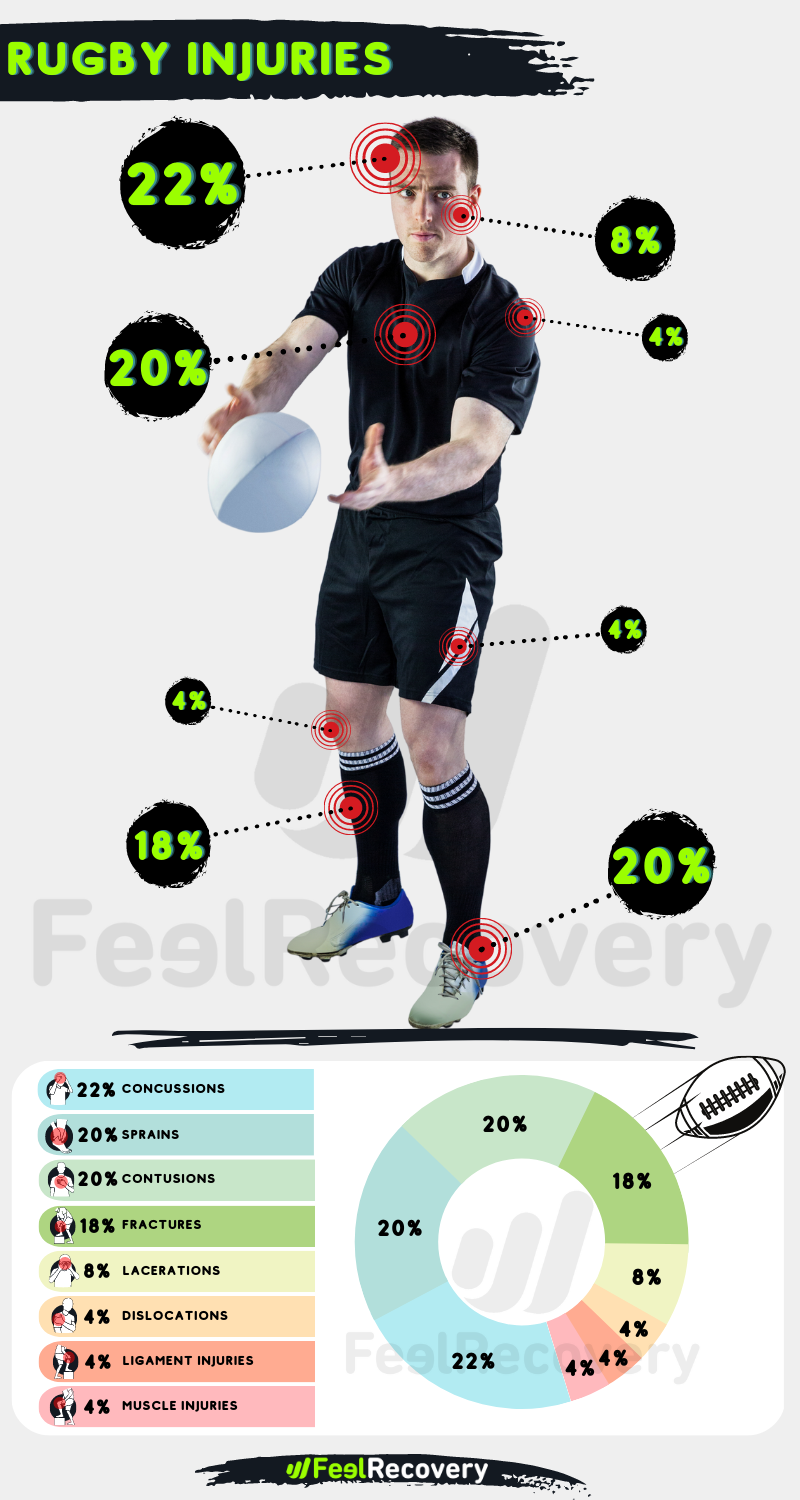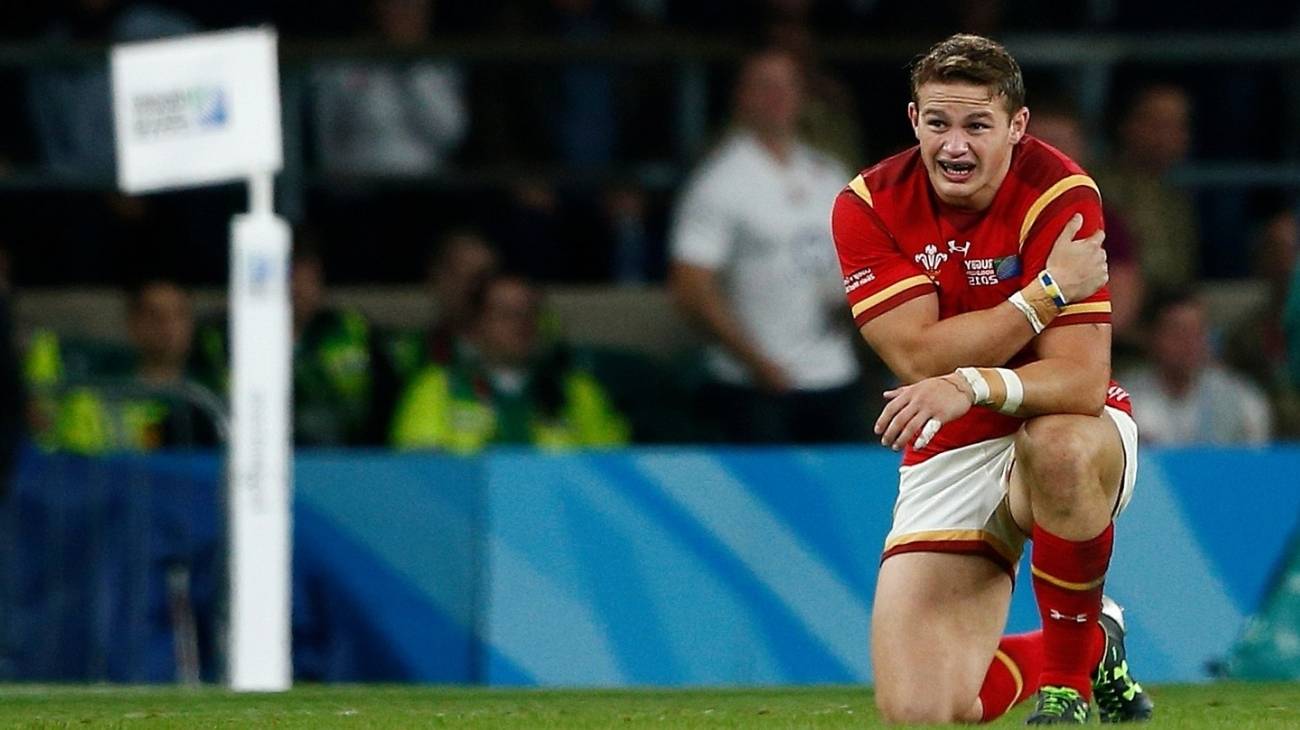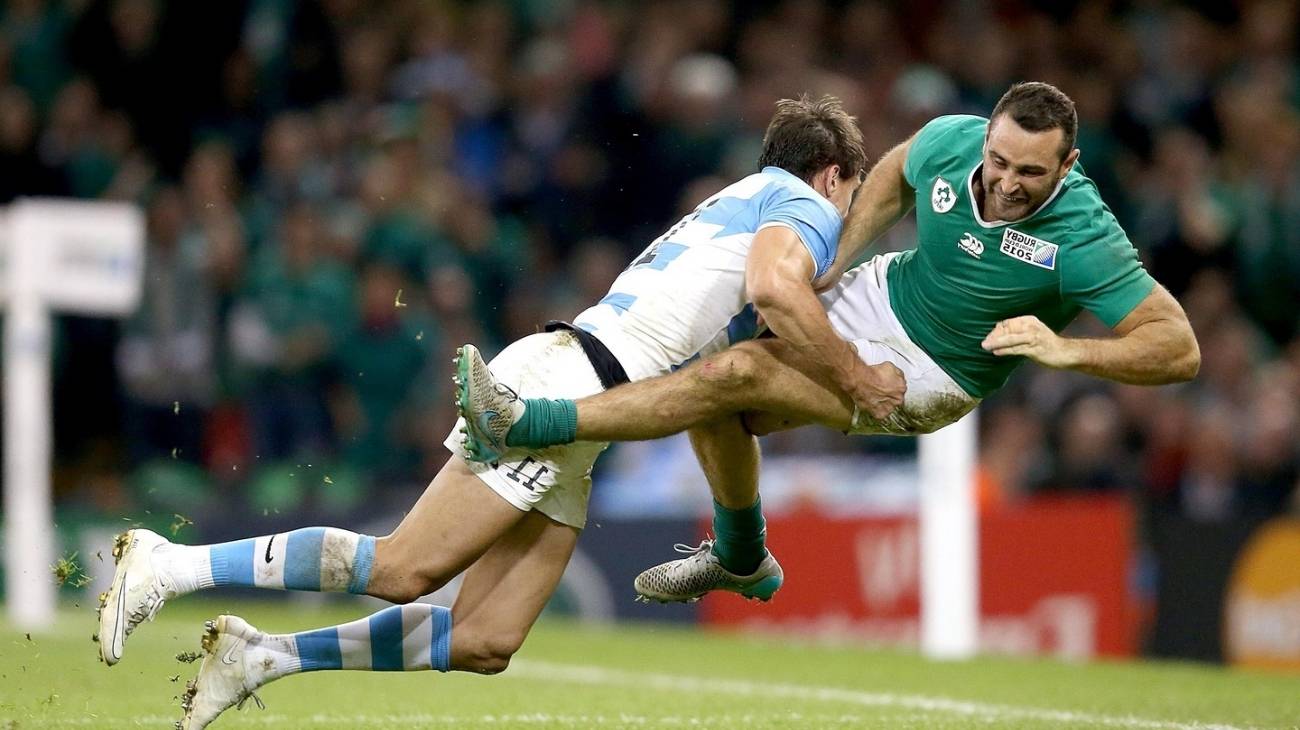Rugby is a contact sport with a high risk of injury. If you've played or watched rugby, you know that bumps, falls, runs and sudden stops are all part of the game. So it is no surprise that there are several types of sports injuries common in rugby. This is especially because rugby players do not use much protection compared to other similar disciplines.
Knowing the most common rugby injuries is essential for every rugby player and coach, so today we will tell you about them. In addition, we will give you some preventive measures so that you can play with the lowest possible risk. Are you ready? Here we go!
What are the most common types of injuries when playing rugby?
There are various types of sports injuries in rugby. Fractures, sprains, strains and other traumatic injuries are common, although overuse injuries are also common. Neck, knee and shoulder injuries are also common. However, rugby players often suffer from injuries in other areas, such as ankle sprains.
The most common types of rugby injuries are:
Head injuries
Rugby players are prone to head injuries, especially concussions. This is undoubtedly related to the fact that rugby players may not wear helmets. In addition, some claim that rugby helmets do not offer sufficient protection. Either way, front tackles pose a high risk to the head.
The most common head injuries in rugby are:
- Concussion: This is a traumatic injury to the brain usually caused by a blow or jolt to the head. It causes dysfunction of the brain which is usually temporary. Headache, nausea, fatigue, blurred vision, confusion and amnesia are among the main symptoms.
- Facial fracture: Arises due to a strong impact on the face capable of breaking one or more facial bones. Nasal fractures are among the most common in rugby. Pain, swelling, bleeding and deformity are the main symptoms.
Neck injuries
Neck injuries are very common in rugby due to the nature of the discipline. Although most neck injuries are minor, some can have serious consequences such as quadriplegia or even death.
The most common neck injuries in rugby are:
- Cervical fracture: This is the breaking of one of the bones in the cervical spine. It can cause a lot of local pain, paralysis or even death depending on the severity. It is caused by trauma such as a severe impact or fall.
- Cervical dislocation: Occurs when one or more of the bones of the cervical spine move from their usual place. It can cause severe local pain, pinching of the nerves associated with the upper limbs, paralysis and death, depending on the severity. It is traumatic in etiology and can be caused by a fall or collision. It may occur with or without a fracture in the area.
- Neck strain: Refers to overstretching or tearing of the muscles and tendons in the neck. It manifests as local pain that may spread to adjacent areas accompanied by stiffness. It occurs when the neck is subjected to trauma (fall, blow) or mild but constant strain (poor posture, repetitive use).
- Cervical facet syndrome: This is inflammation, irritation or damage to the facet joint of the cervical vertebrae. It is characterised by axial neck pain, which may radiate closely, and stiffness. It is associated with ageing, repetitive stress, trauma, among other causes.
- Brachial plexus injury: Occurs when the nerves of the brachial plexus nerve network are compressed, stretched, torn or separated from the spinal cord. Milder injuries are known as stingers or burners and are common in rugby. However, more serious conditions such as avulsions of these nerves can also occur in rugby.
- Cervical disc injuries: Of particular note here are herniated and bulging discs in the cervical spine. These can compress the nerve roots causing weakness, pain, tingling and numbness in the upper extremities. They can occur due to age-related disc degeneration or trauma such as a fall or blow.
Shoulder injuries
They are one of the most common sports injuries in rugby. In this sport there are frequent impacts and leverage on the shoulder, which in itself is not very stable. Tackles are responsible for a large number of dislocations, fractures and other conditions in this joint area.
The most common shoulder injuries in rugby are:
- Shoulder dislocation: Occurs when the head of the humerus slips out of the glenoid joint cavity. Anterior dislocations are more common than dislocations in other directions. They are caused by severe trauma such as a fall, blow, blow, stretch or rotation.
- Acromioclavicular joint sprain: Occurs when the ligaments of the acromioclavicular (AC) joint of the shoulder are overstretched or torn. It may or may not involve dislocation (partial or total) of the AC joint depending on the extent of the injury. Often results from a fall on the posterosuperior aspect of the shoulder.
- Rotator cuff tear: The rotator cuff (RM) can be partially or completely torn during a rugby match. This can happen as a result of overuse or due to trauma, usually during a fall or tackle. The supraspinatus tendon of the RM is the most prone to rupture.
- SLAP injuries: Involve partial or complete tearing of the upper part of the glenoid labrum of the shoulder. May result from repetitive use or trauma such as a fall on the outstretched arm or elbow.
- Fracture: Fractures of the clavicle and epiphysis of the humerus are common in rugby players. They involve the breaking or shattering of these bones, usually due to trauma during play. Intense pain, bruising and deformity are among the main symptoms.
Elbow and hand injuries
Rugby players can also sustain hand and elbow injuries during a game or training. The nature of the contact sport means that there is a risk of traumatic injuries to these areas, such as finger dislocations. However, overuse conditions such as tennis elbow are also common in this discipline.
Hand and elbow injuries in rugby include the following:
- Tennis elbow (lateral epicondylitis): This is a tendonitis that occurs in the tendons of the extensor muscles of the forearm that originate in the epicondyle on the side of the elbow. It causes pain in this area of the elbow that can spread to other parts of the arm. It is considered an overuse condition.
- Dislocated fingers: Occurs when the bones in the fingers slip out of place. They occur most often in the proximal interphalangeal (PIP) joint of the fingers. It is usually caused by a blow, fall or other trauma that hyperextends the finger backwards.
Chest and lower back injuries
Injuries to the chest and lower back can also occur in rugby, either during play or training. The contact nature of the sport puts these areas of the body at risk. In addition, the weightlifting that many rugby players train with is a risk factor for lower back injuries.
The following injuries to the chest and lower back are common in rugby:
- Rib fracture: This is a chest injury that occurs when one or more of the ribs is broken or cracked. It is caused by trauma to the chest, such as a heavy impact during a rugby match. It causes pain and can cause damage to blood vessels and internal organs.
- Lumbar strain: A lower back injury that involves hyperextension or tearing of the lumbar muscles and tendons. It can result from twisting, stretching or other movement that puts too much strain on this area. Sudden low back pain is one of its main symptoms.
Knee injuries
These are among the most common sporting injuries in rugby and some of them can be career-ending. Acute knee conditions, especially sprains and meniscus tears, caused by trauma during a tackle usually stand out. Overuse pathologies also occur due to running, jumping and other movements that put stress on this joint during play.
The most common knee injuries in rugby are:
- Knee ligament sprain: This is the overstretching or tearing of one or more ligaments in the knee. The cruciate (anterior and posterior) and collateral (medial and lateral) ligaments are among the most commonly affected. It is caused by trauma such as a blow to the knee or twisting of the knee with the foot flat on the ground.
- Meniscal tear: This involves a tear in one of the menisci (C-shaped cartilage) of the knee. It presents as local pain and swelling that may be accompanied by popping and a sensation of failure or locking of the knee. It is traumatic in etiology and usually occurs from a twisting motion with the knee flexed and the foot planted on the ground.
- Patellar tendonitis: This is the gradual degeneration of the patellar tendon in the knee. It is characterised by pain just below the kneecap. It is considered an overuse injury, i.e. caused by repetitive overloading of the tendon from activities such as constant jumping and running.
- Patellofemoral pain syndrome: Basically consists of pain in the femur-patella joint and adjacent soft tissues at the front of the knee. It is generally associated with overuse, abnormalities (anatomical or biomechanical), muscle imbalance, patellar trauma (blow, dislocation, fracture...), among others.
- Fracture of the patella: This involves a break of the patella, the triangular bone at the front of the knee. Intense pain, swelling and loss of mobility are the main symptoms. It is mainly caused by a hard fall or blow to the knee, although rapid contraction of the quadriceps can also cause it.
- Iliotibial band syndrome: This injury causes pain and/or tenderness on the outside of the knee. It is thought to be the product of friction or compression of the iliotibial band at the knee. It is usually associated with overuse generated by activities such as running, cycling, among others. Weakness in the hip abductor muscles is also a risk factor.
Lower limb injuries
There are also common rugby injuries that affect areas of the lower limbs other than the knee. Rugby players can suffer muscle strains in the leg as well as foot and ankle conditions. Constant running and sudden stops during play have a lot to do with this.
Rugby players also often suffer from these lower limb injuries:
- Hamstring strain: This is a thigh injury and involves overstretching or tearing of the hamstrings. Poor warm-up, weakness, muscle imbalance, limited flexibility and other factors can contribute to its occurrence.
- Ankle sprain: Occurs when the ligaments of the ankle are hyperextended or torn. It occurs most often in the external ligaments. This can be caused by poor footing, especially on uneven ground.
- Plantar fasciitis: This is a foot injury that involves inflammation of the plantar fascia. It causes a shooting pain in the heel, especially when waking up in the morning. It is believed to be the result of risk factors such as ageing, constant running, prolonged standing, overweight, among others.
Best products for rugby injury recovery
Bestseller
-
2 Calf Compression Sleeve (Black/Gray)
£17,50 -
2 Calf Compression Sleeve (Green/Navy)
£17,50 -
2 Calf Compression Sleeve (Pink/Bordeaux)
£17,50 -
2 Knee Compression Sleeve (Black/Gray)
£17,50 -
2 Knee Compression Sleeve (Green/Navy)
£17,50 -
2 Knee Compression Sleeve (Pink/Bordeaux)
£17,50 -
2 Thigh Compression Sleeve (Black/Gray)
£17,50 -
2 Thigh Compression Sleeve (Green/Navy)
£17,50 -
2 Thigh Compression Sleeve (Pink/Bordeaux)
£17,50 -
Acupressure Mat and Pillow (Black/Gray)
£44,95 -
Acupressure Mat and Pillow (Green/Navy)
£44,95 -
Acupressure Mat and Pillow (Pink/Bordeaux)
£44,95 -
Acupressure Pillow (Black/Gray)
£21,52 -
Acupressure Pillow (Green/Navy)
£21,52 -
Acupressure Pillow (Pink/Bordeaux)
£21,52 -
Back Support Belt (Black)
£29,95 -
Back Support Belt (Green)
£29,95 -
Back Support Belt (Pink)
£29,95 -
Foot Massage Roller for Plantar Fasciitis (Black)
£17,50 -
Foot Massage Roller for Plantar Fasciitis (Green)
£17,50 -
Foot Massage Roller for Plantar Fasciitis (Pink)
£17,50 -
Gel Eye Mask for Puffy Eyes (Gold/Black)
£9,95 -
Gel Eye Mask for Puffy Eyes (Orange/Pink)
£9,95 -
Gel Eye Mask for Puffy Eyes (Purple/Turquoise)
£9,95 -
High Density Foam Roller for Muscle (Black/Gray)
£21,95 -
High Density Foam Roller for Muscle (Green/Navy)
£21,95 -
High Density Foam Roller for Muscle (Pink/Bordeaux)
£21,95 -
Ice Massage Roller Ball (Black)
£34,95 -
Ice Massage Roller Ball (Green)
£34,95 -
Ice Massage Roller Ball (Pink)
£34,95 -
Microwave Wheat Bag for Back Pain Relief (Extra Large) (Hearts)
£25,50 -
Microwave Wheat Bag for Back Pain Relief (Extra Large) (Oxford)
£25,50 -
Microwave Wheat Bag for Back Pain Relief (Extra Large) (Sport)
£25,50 -
Microwave Wheat Bag for Neck & Shoulder Pain Relief (Hearts)
£21,50 -
Microwave Wheat Bag for Neck & Shoulder Pain Relief (Oxford)
£21,50 -
Microwave Wheat Bag for Neck & Shoulder Pain Relief (Sport)
£21,50 -
Microwave Wheat Bag for Neck Pain Relief (Hearts)
£17,50 -
Microwave Wheat Bag for Neck Pain Relief (Oxford)
£17,50 -
Microwave Wheat Bag for Neck Pain Relief (Sport)
£17,50 -
Pack 2 in 1: Foam Roller High + Soft Density (Black/Gray)
£24,95 -
Pack 2 in 1: Foam Roller High + Soft Density (Green/Navy)
£24,95 -
Pack 2 in 1: Foam Roller High + Soft Density (Pink/Bordeaux)
£24,95 -
Shoulder Support Brace (Black)
£21,95 -
Shoulder Support Brace (Green)
£21,95 -
Shoulder Support Brace (Pink)
£21,95 -
Soft Density Foam Roller for Recovery (Black)
£24,95 -
Soft Density Foam Roller for Recovery (Green)
£24,95 -
Soft Density Foam Roller for Recovery (Pink)
£24,95 -
Trigger Point Massage Stick (Black)
£12,95 -
Trigger Point Massage Stick (Green)
£12,95 -
Trigger Point Massage Stick (Pink)
£12,95
How to prevent injuries when playing rugby?
If you want to play rugby without getting injured then you should read this segment. Below is a list of methods that will help you prevent rugby injuries. While they do not eliminate the possibility of a game or training injury, they significantly reduce the risk:
- Warm up properly: It is important to warm up for approximately 10-20 minutes just before a rugby practice or match. This should include cardio exercises, joint movements, stretching and other activities. This prepares the body, especially the muscles, for the sporting activity with minimal risk of injury.
- Finish training with a cool-down: After the match or training session, it is necessary to stretch for approximately 15 minutes. The aim of this is to gradually return the body to its resting state, which helps to prevent injuries. Light, relaxing activities such as walking, breathing and stretching are recommended at this stage.
- Good nutrition and hydration: The demanding training and juicing conditions of rugby require proper nutrition for rugby players. Adequate intake of quality wholegrain carbohydrates, protein-rich foods, healthy fats, plenty of vegetables and fruits is recommended. It is also essential that the player stays hydrated, especially during sporting activity.
- Improve your physical fitness: Rugby players need to train to be physically fit for rugby. In particular, rugby players must have sufficient strength, speed and endurance. Otherwise, the risk of injury is increased.
- Sports massage: Sports massages are helpful in the treatment and prevention of common rugby injuries. They can be used prior to sporting activity to prepare players, or afterwards to promote muscle relaxation and recovery.
- Use of heat/cold therapy: Also known as contrast therapy, this is basically the application of alternating heat and cold. It has excellent analgesic and anti-inflammatory properties and also helps to reduce fatigue. These virtues make it ideal for treating and preventing injuries.
- Use of compression garments: Compression garments (T-shirts, shorts, socks, sleeves...) have excellent benefits. Wearing them before, during and after rugby training and games reduces the risk of injury and generates greater endurance. In addition, they also promote recovery after physical activity according to some studies.
- Use of acupressure therapies: Acupressure therapies involve the application of pressure to specific points on the body. It is attributed with analgesic and muscle relaxation properties, among others. For this reason, it is used in the recovery and prevention of sports injuries such as those originating in rugby.
- Use of thermotherapy and cryotherapy: Thermotherapy promotes flexibility and circulation, relieves pain and reduces inflammation. Cryotherapy works as an analgesic and anti-inflammatory and reduces spasms. Both therapies are used to treat and prevent injuries.
- Use of appropriate equipment: Shirts, shorts, shoes and other clothing should be comfortable, conform to standards and be in good condition. Ideally, the player should wear protective gear such as helmets, shin guards, ankle guards, mouth guards, among others, although they are not mandatory.
How to apply the RICE therapy to treat first aid injuries in rugby players?
The RICE therapy is widely recommended for acute sports injuries in rugby. Each letter of its name refers to a step to be exercised during its application: Rest, Ice, Compression and Elevation. There is also an update to this method, a little less well known, called PRICE. As you can see, the latter adds a new step: Protection.
Both protocols are recommended primarily for treating injuries in the acute phase, i.e. during the first 48 to 72 hours after they occur. They work excellently for sprains, strains, sprains and inflammatory injuries such as tendonitis. However, they are not generally indicated for chronic conditions.
Here's how to apply the PRICE therapy to common acute rugby injuries:
- Protection: You should protect the injured area by avoiding the activity that caused the injury. It is important to avoid movements, therefore, the use of an immobiliser such as ankle braces, slings, among others, is recommended.
- Rest: Rest should be provided to the injured area for approximately 48 hours. However, it is important to make certain safe and gentle movements to prevent stiffness from developing.
- Ice: Cryotherapy is used at this stage for its anti-inflammatory, antispasmodic and analgesic properties. Basically, you should apply a cold compress to the injury for 20 minutes about 6 to 8 times a day.
- Compression: In this case, pressure should be exerted on the injury to promote circulation, reduce inflammation and firm it up. It is usual to use a flexible fabric to bandage the area in question. Do not apply too much pressure or the circulation may be cut off.
- Elevation: You should elevate the injured limb to a height above the heart. To do this you could rest the injured limb on a cushioned surface such as a pillow. This will have a de-inflammatory and analgesic effect.
References
- Kaplan, K. M., Goodwillie, A., Strauss, E. J., & Rosen, J. E. (2008). Rugby injuries. Bulletin of the NYU hospital for joint diseases, 66(2), 86-93. https://www.safetylit.org/citations/index.php?fuseaction=citations.viewdetails&citationIds[]=citjournalarticle_88090_11
- Freitag, A., Kirkwood, G., Scharer, S., Ofori-Asenso, R., & Pollock, A. M. (2015). Systematic review of rugby injuries in children and adolescents under 21 years. British journal of sports medicine, 49(8), 511-519. https://bjsm.bmj.com/content/49/8/511.short
- Bottini, E., Poggi, E. J. T., Luzuriaga, F., & Secin, F. P. (2000). Incidence and nature of the most common rugby injuries sustained in Argentina (1991–1997). British Journal of Sports Medicine, 34(2), 94-97. https://bjsm.bmj.com/content/34/2/94.short
- Gibbs, N. (1994). Common rugby league injuries: recommendations for treatment and preventative measures. Sports Medicine, 18, 438-450. https://link.springer.com/article/10.2165/00007256-199418060-00007
- Carson, J. D., Roberts, M. A., & White, A. L. (1999). The epidemiology of women's rugby injuries. Clinical Journal of Sport Medicine, 9(2), 75-78. https://journals.lww.com/cjsportsmed/abstract/1999/04000/the_epidemiology_of_women_s_rugby_injuries.6.aspx
- Quarrie, K. L., & Hopkins, W. G. (2008). Tackle injuries in professional rugby union. The American journal of sports medicine, 36(9), 1705-1716. https://journals.sagepub.com/doi/abs/10.1177/0363546508316768
- Quarrie, K. L., Cantu, R. C., & Chalmers, D. J. (2002). Rugby union injuries to the cervical spine and spinal cord. Sports Medicine, 32, 633-653. https://link.springer.com/article/10.2165/00007256-200232100-00003
- Brooks, J. H., Fuller, C. W., Kemp, S. P., & Reddin, D. B. (2006). Incidence, risk, and prevention of hamstring muscle injuries in professional rugby union. The American journal of sports medicine, 34(8), 1297-1306. https://journals.sagepub.com/doi/abs/10.1177/0363546505286022
- Silver, J. R., & Stewart, D. (1994). The prevention of spinal injuries in rugby football. Spinal Cord, 32(7), 442-453. https://www.nature.com/articles/sc199471
- Newton, D., England, M., Doll, H., & Gardner, B. P. (2011). The case for early treatment of dislocations of the cervical spine with cord involvement sustained playing rugby. The Journal of Bone and Joint Surgery. British volume, 93(12), 1646-1652. https://boneandjoint.org.uk/article/10.1302/0301-620X.93B12.27048















































































